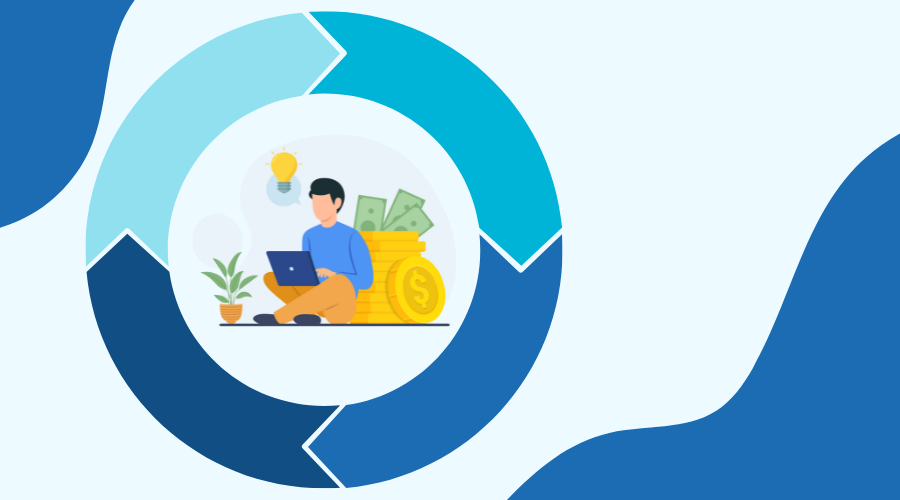Do you have a great product or service and a hard-working sales team yet go months before closing the sale? Sounds like you have a typical B2B sales cycle.
If you’re in B2B sales, you know that deals don’t just happen overnight. Buyers don’t click “add to cart” and check out in minutes. Instead, you’re dealing with a much longer, more involved process—one that includes multiple people, careful evaluation, and a lot of decision-making behind the scenes. That’s the B2B sales cycle, and it plays a critical role in determining how fast (or slow) your deals close, how successful your outreach is, and ultimately how scalable your sales process becomes.
The more you understand the sales cycle, the more control you have over how you approach leads, qualify them, and close them. In this guide, we’ll break down exactly what the B2B sales cycle is, how it differs from B2C, what to expect at each stage, and what strategies can help you close more deals faster—without sacrificing the buyer experience.
What is the B2B Sales Cycle?
At its core, the B2B sales cycle is the process businesses follow to sell products or services to other businesses. It’s a multi-step journey that begins the moment a potential buyer identifies a need and ends when they sign the deal—and sometimes even extends into post-sale relationship-building.
Unlike B2C, where purchasing decisions are often quick and emotional, B2B sales involve more logic, more planning, and often more people. Each step must be navigated thoughtfully, with clear messaging, tailored information, and well-timed follow-up.
A typical B2B sales cycle involves several stages: awareness, research, consideration, evaluation, decision, and post-sale onboarding or relationship management. The full cycle can span anywhere from a few weeks to several months, depending on the industry, the complexity of the offering, and the size of the company you’re selling to.
Understanding this process gives you the advantage of knowing where your prospect stands and what they need to move forward. It helps you identify bottlenecks, customize your approach, and focus your energy on the right leads at the right time.
B2B Sales Cycle vs. B2C: What’s the Difference and Why It Matters
Too often, B2B sellers apply tactics that work in a B2C environment—and then wonder why nothing’s sticking. The problem isn’t always the product or service. More often than not, it’s a misunderstanding of how buyers behave and what they need to make a decision.
In B2C, the customer is typically one person. They’re making a fast, individual choice, sometimes based on emotion, branding, or price. In contrast, B2B decisions usually involve multiple stakeholders: procurement, department heads, finance, and sometimes even legal teams. That means your messaging has to speak to various concerns—cost, ROI, risk, implementation timeline, and long-term impact.
The stakes are also higher in B2B. You’re often talking about large financial commitments or tools that impact how a company runs. That adds pressure, and it slows things down. Trust plays a bigger role, and buyers want to feel confident they’re choosing the right partner—not just a product.
So why does this matter? Because it affects every piece of your sales strategy. From how you structure your outreach to how you present pricing, timelines, and onboarding—you need to be thinking about the long game. Patience, clarity, and follow-through are your biggest assets.
The Typical B2B Sales Cycle Process
While the sales cycle can vary depending on the product, price point, and buyer complexity, most B2B sales journeys follow a similar process. It’s not a quick “talk and sign” situation—especially in industries like construction, software, or services. Instead, it’s a step-by-step path where each stage plays a role in building trust and moving the buyer closer to a decision.
These deals take time—especially when multiple decision-makers are involved or the offering is more complex. Here’s what the full process usually looks like:
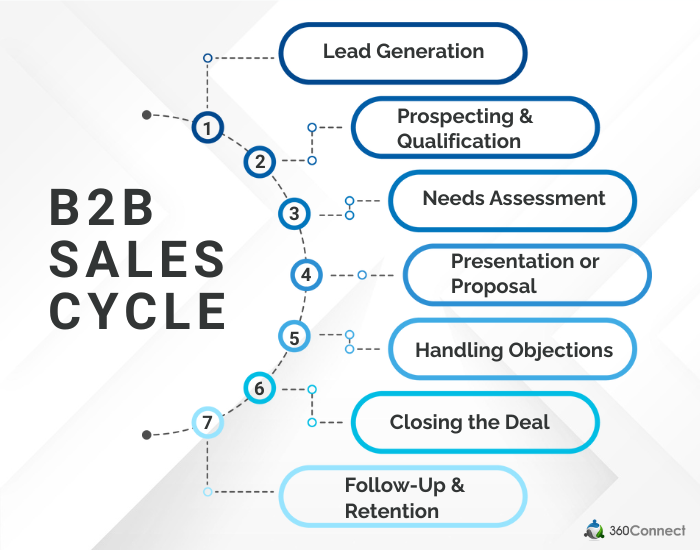
1. Lead Generation
Every sales journey starts with finding potential buyers. The goal at this stage is to connect with high-quality leads who may benefit from your product or service—and begin the conversation in a way that feels relevant and timely. High-quality leads are those who not only show interest but also fit your ideal customer profile.
There are several common ways to generate quality B2B leads:
- Inbound marketing like blogs, whitepapers, or webinars
- Search engine optimization (SEO) to capture organic traffic
- Referral programs or partnerships
- Paid ads on platforms like Google, Bing, or LinkedIn
- Cold outreach through email or calls
- Working with an online marketplace that matches buyers with relevant suppliers
- Attending trade shows and networking events to build your contact list
The most successful companies prioritize lead quality over quantity. You’re not just collecting names—you’re looking for high-quality potential buyers with genuine interest, a budget, and buying authority.
2. Prospecting & Qualification
Once leads come in, it’s time to qualify them. This step is about filtering out the “just curious” from the serious buyers so your sales team can focus its energy where it counts.
Key questions to ask:
- Is this person the decision-maker, or will someone else sign off?
- Do they have a real need for what you offer?
- What is their budget and timeline?
- Are they comparing other options right now?
This step can involve brief discovery calls, lead scoring tools, or email exchanges to assess fit.
3. Needs Assessment
Now that you’ve confirmed the lead is a good fit, it’s time to understand what they actually need. This is where listening matters more than pitching. You want to ask thoughtful questions to uncover their biggest challenges, goals, and must-haves.
This stage helps you tailor your solution so it feels personalized—not cookie-cutter.
Common ways to assess needs:
- Discovery calls or intake meetings
- Email questionnaires or onboarding forms
- Case studies or use cases to spark conversation
4. Presentation or Proposal
Once you know what the buyer is looking for, you’re ready to present a tailored solution. This could take the form of a product demo, pricing quote, sales deck, or formal proposal—whatever matches their buying style.
This is where you focus on value, not features. Tie every part of your offer back to how it solves their pain point or improves their operations.
Key elements to include:
- Clear pricing and terms
- Visuals or demos where possible
- ROI or case studies to show proof
5. Handling Objections
At this point, the buyer is interested—but not 100% ready. Expect questions, concerns, or pushback. This is completely normal. Most objections fall into common categories: pricing, timing, complexity, or internal approval.
Your job is to respond with clarity, patience, and empathy. This part of the cycle often determines whether the deal moves forward or falls apart.
Tips for handling objections:
- Don’t interrupt—let them share their concerns fully
- Provide clear documentation or comparisons
- Involve technical or support reps if needed
6. Closing the Deal
You’ve answered the tough questions, and now it’s time to close. This phase involves finalizing the agreement, signing contracts, and preparing for onboarding.
How you handle this step matters—it sets the tone for the relationship going forward. Make sure everything is clear, simple, and transparent.
Best practices for a smooth close:
- Confirm all agreed-upon details in writing
- Send a contract that’s easy to understand and sign
- Include onboarding steps or FAQs to prevent confusion
7. Follow-Up & Retention
The sale is done—but your work isn’t. The post-sale experience is where long-term value lives. Checking in, offering support, and staying top-of-mind can lead to repeat business, referrals, or upsells down the line.
Some ways to stay engaged:
- Follow-up calls or emails 30–60 days after the sale
- Educational emails or updates about new features
- Referral programs or loyalty perks
Understanding the B2B Sales Cycle: Stages, Timeline, and What to Expect
Now that you know the typical process, let’s take a deeper look at the key stages of a typical B2B sales cycle. While exact terminology may vary, most processes follow a similar structure. Knowing what to expect in each stage—and how to guide the buyer through it—is essential for success.
STAGES
You’ve seen how your internal sales process flows. Now let’s take a look at the buyer’s journey—because understanding what’s going on in their head is just as important.
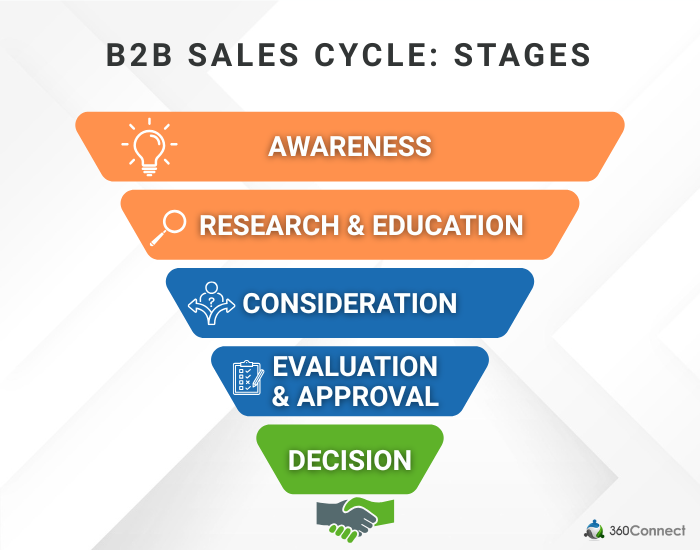
Stage 1: Awareness
The buyer recognizes a challenge, gap, or inefficiency in their current setup. This might be triggered by a business change, new goals, or outside pressure like rising costs or market competition. Your job at this stage is to be visible—through content, SEO, paid ads, or industry referrals—so when the need arises, they discover your solution.
Stage 2: Research & Education
Once a buyer knows they have a problem, the next step is researching potential solutions. This is where they explore blogs, watch videos, download guides, and start building a short list of companies that might be able to help. Sellers who provide genuinely helpful, easy-to-understand information often stand out here. Think educational blogs, solution pages, FAQs, or short videos that show you understand the problem and can solve it.
Stage 3: Consideration
At this point, buyers are narrowing their options. They’ve identified a few possible vendors, and they’re comparing features, pricing, support, reviews, and case studies. You’ll often see more direct engagement at this stage: quote requests, demos, and consultation calls. It’s important here to listen to their specific needs and tailor your messaging accordingly. A generic pitch won’t cut it—they want to know how your solution fits their exact situation.
Stage 4: Evaluation & Approval
This is often the longest and most frustrating part of the process—especially if you’re not looped in on internal discussions. At this stage, the buyer is bringing in other stakeholders for feedback and signoff. This could include operations managers, CFOs, procurement officers, or even legal. They’ll be reviewing proposals, comparing ROI, and asking tough questions. Being clear, responsive, and proactive can keep the deal from stalling.
Stage 5: Decision
If everything goes well, this is when the deal closes. But even here, things can fall apart if you’re not careful. Contracts should be straightforward. Pricing should match expectations. Onboarding should be clearly outlined. The easier you make the final step, the more confident the buyer will feel signing on the dotted line.
Optional Stage: Post-Sale
While the formal sales cycle may end with the contract, the buyer’s journey doesn’t. Onboarding, support, and relationship-building can lead to future upsells, referrals, and long-term loyalty. Don’t drop the ball once the sale is made—keep the momentum going.
Pro Tip: You’ll find that most businesses use a similar B2B Sales Cycle diagram or flow, however, what you’ll want to do is use this as a guideline to then customize it based on your product, service, or industry. Remember, there’s hardly ever a one-size solution (or chart) that works for everyone.
TIMELINE
Now that we’ve looked at what happens during the cycle, let’s talk about how long it typically takes—because managing expectations around timelines is just as critical as mastering your pitch.
Typical Timeline for B2B Sales Cycle
In B2B sales, the duration of the sales cycle varies from business to business. The following are some common timeframes to expect:
- Small or Straightforward B2B purchases may close in 30–60 days
- Mid-size deals often take 3–6 months
- Enterprise or high-ticket sales can stretch to 6–12 months (or more)
- Average B2B Sales Cycle: About 6 months
However, factors like industry, product complexity, and the number of decision-makers involved can significantly affect the timeline.
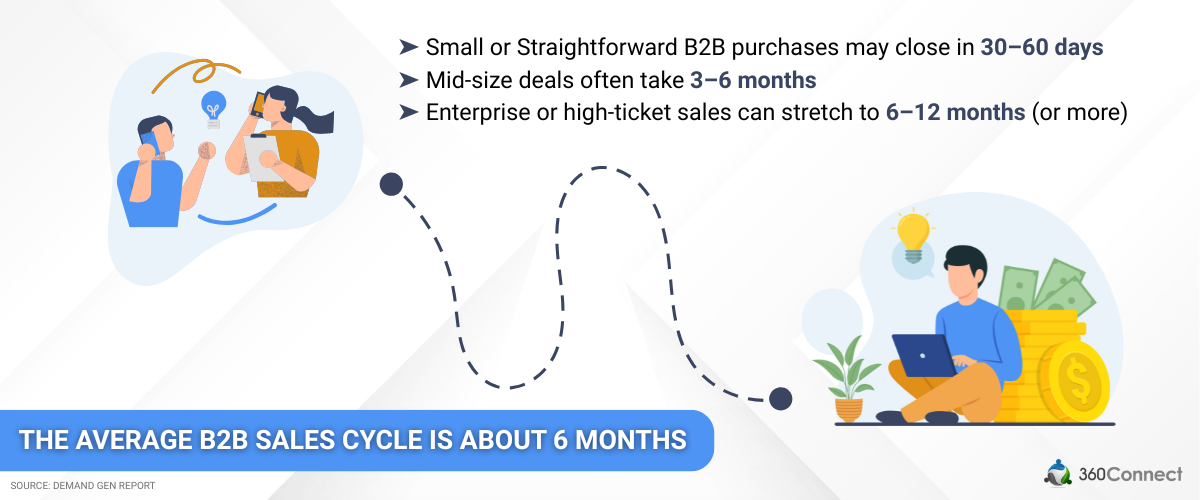
WHAT TO EXPECT
What to Expect Throughout the B2B Sales Cycle
You know the stages, you’ve seen how long it can take—now it’s time to set expectations.
The truth? The B2B sales cycle isn’t always smooth. It can be slow, filled with follow-ups, and involve more decision-makers than you expected. Buyers might go quiet, priorities might shift, and deals that seemed close to done can stall.
But that doesn’t mean you’re doing something wrong.
What matters is how you show up during the process. Stay consistent, be helpful, and keep the momentum going. The more value you offer at each stage, the more trust you build—and that’s what really helps close the deal.
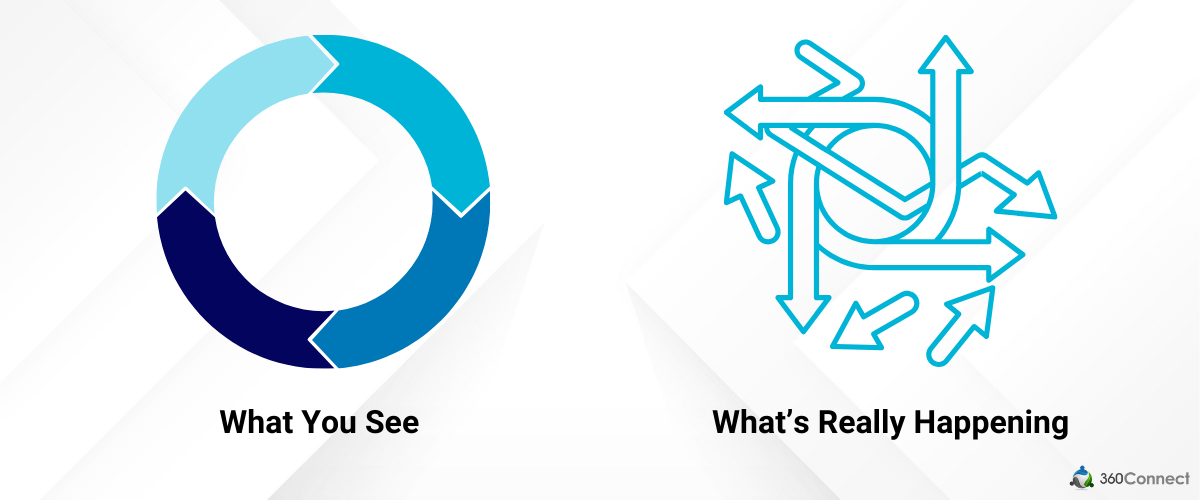
Top Mistakes to Avoid at Each Stage of the B2B Sales Cycle
Even seasoned sales pros make mistakes—but when you know what to look out for, you can avoid unnecessary delays and deal loss. Here are common pitfalls at each stage of the cycle:
Awareness Stage:
- Mistake: Not showing up where buyers are looking. If you’re not ranking on Google or participating in industry spaces, you’re invisible.
- Fix: Improve SEO, invest in paid ads, and establish a presence in the places your buyers hang out.
Research Stage:
- Mistake: Relying on a basic website or outdated content.Buyers are forming first impressions based on what they read and see online.
- Fix: Create high-quality, educational content that positions your company as a trusted resource.
Consideration Stage:
- Mistake: Focusing too much on features instead of benefits. Buyers care about outcomes—how you’ll solve their problem—not how your tech stack works.
- Fix: Customize your messaging to their needs and focus on ROI.
Evaluation Stage:
- Mistake: Being slow to respond or not addressing stakeholder concerns. This is where many deals stall or fall apart due to miscommunication.
- Fix: Respond quickly, anticipate objections, and ask who else is involved in the decision-making process.
Decision Stage:
- Mistake: Making the buying process harder than it needs to be. Long contracts, confusing pricing, or slow onboarding can kill a deal.
- Fix: Streamline final steps and walk the buyer through what happens after they sign.
How to Shorten Your B2B Sales Cycle
Long sales cycles can be draining. While some delays are out of your control, many are preventable. If your deals are dragging on, here are some ways to speed things up without coming off as pushy:
Qualify Leads Early in the B2B Sales Cycle
Don’t waste time on prospects who aren’t ready or aren’t a good fit. Use your initial conversations to uncover timeline, budget, and level of urgency. If a lead isn’t serious, put them in a nurture sequence and focus on hotter opportunities.
Related: What is a Lead Verification Service?
Automate Repetitive Tasks
Use tools like CRMs or marketing automation to streamline follow-up, send reminders, and keep track of where each lead is in the cycle. You’ll spend less time chasing people and more time closing.
Related: How to Grow Your Business With Marketing Automation
Share Pricing and Info Up Front
Many sellers hold back on pricing until the very end—but that can delay the process and lead to sticker shock. Be transparent. Sharing ballpark numbers, delivery timelines, or service terms early helps buyers self-qualify and keeps things moving.
Involve Stakeholders Sooner
One of the biggest slowdowns happens when new decision-makers enter late in the game. Ask upfront: “Who else will need to approve this?” Then bring them in early to avoid repeating steps later.
Make the Next Step Obvious
Buyers get stuck when they don’t know what to do next. Every time you communicate, end with a clear next step: “Let’s schedule a demo,” “I’ll send a proposal tomorrow,” or “Once I have X, we can finalize the agreement.”
Related: Why Persistence is Key to Closing Sales
Final Thoughts on the B2B Sales Cycle
The B2B sales cycle isn’t something you can avoid—but it’s absolutely something you can master. When you understand what buyers need at each stage, how to meet those needs, and where deals tend to stall, you gain an edge over your competitors. You stop guessing and start guiding. You build trust, shorten timelines, and close more deals with less friction.
Whether you’re managing a small sales team or scaling a larger operation, this cycle is the framework that underpins your success. Keep refining it, keep learning from it, and most of all—keep showing up for your buyers at the right time, with the right message.
Want Qualified Sales Leads?
Ready to skip the cold outreach and connect with buyers who are actively searching for what you offer? At 360Connect, we deliver high-quality B2B leads directly to your inbox—so you can focus on closing, not chasing.

